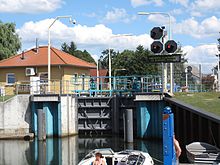Self-service gate

The self-service lock Storkow with a blue request counter, text display and lock signal
A self-service lock is a boat lock where the skipper performs the function of the lock keeper . The self-service can be performed automatically and remotely monitored or manually.
Automatic self-service
Automatic self-service sluices are mainly set up in the area of recreational shipping . Operation is based on the following basic principle:
- The lock is initiated via registration counters in the upper and lower water .
- The entry and exit signals are linked to the controller. Text displays provide information about the lock process, malfunctions and instructions.
- The entry and exit of the lock chamber is usually monitored electronically (e.g. by light barriers ).
- Forwarding and emergency stop switches are located in the lock chamber on each side of the chamber. They can be reached from the boat at all water levels.
- The closing of the gates and the actual lock process are initiated with the forwarding switch.
- The water equalization process can be interrupted at any time with the emergency stop switch.
- At the waiting areas and in the chamber area, intercom systems enable contact to the remote monitoring center, which can intervene via remote dial-in in the event of malfunctions and problems.
Manual self-service
In contrast to automatic self-service, one or more crew members have to leave the watercraft in order to be able to carry out the lock. The order in which the miter gates and gate valves are operated depends on the direction of travel and the water level in the lock chamber upon arrival. Manual self-service sluices can still be found on the Upper Ems , for example .
Web links
Commons : self-service gates - collection of images, videos and audio files
- Self-service gate operating instructions. (PDF) Federal Waterways and Shipping Administration , accessed on April 18, 2015 .
- Instructions for using the Bremen small ship lock. (PDF) WSA Bremen , July 2011, accessed on April 18, 2015 .
Individual evidence
- ↑ Travel without limits - the water sports area "Ems-Dollart" . Landesverband Motorbootsport Niedersachsen, 2012, p. 11 .
